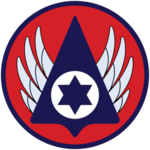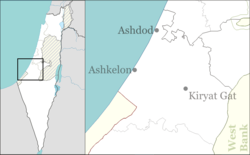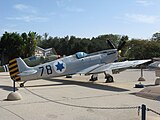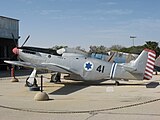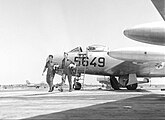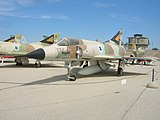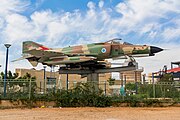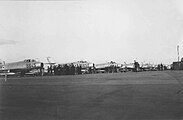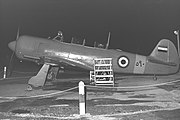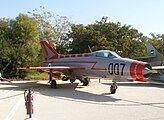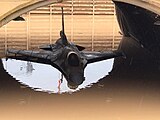Hatzor Airbase
| Hatzor Israeli Air Force Base Air Wing 4 | |||||||||||
|---|---|---|---|---|---|---|---|---|---|---|---|
בָּסִיס חֵיל-הַאֲוִויר חָצוֹר | |||||||||||
| Hatzor, Southern District in Israel | |||||||||||
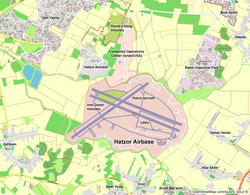 | |||||||||||
| Coordinates | 31°45′45.00″N 34°43′38.00″E / 31.7625000°N 34.7272222°E | ||||||||||
| Type | Airbase | ||||||||||
| Site information | |||||||||||
| Owner | Israel Defense Forces | ||||||||||
| Operator | Israeli Air Force | ||||||||||
| Site history | |||||||||||
| Built | 1942 RAF / 1948 IAF | ||||||||||
| In use | 1942 – present | ||||||||||
| Airfield information | |||||||||||
| Identifiers | ICAO: LLHS | ||||||||||
| Elevation | 45 metres (148 ft) AMSL | ||||||||||
| |||||||||||

Hatzor Airbase (Hebrew: בָּסִיס חֵיל-הַאֲוִויר חָצוֹר) (ICAO: LLHS), also titled Kanaf 4 (lit. Wing 4) is an Israeli Air Force (IAF) base, located in central Israel near kibbutz Hatzor Ashdod after which it is named. However, there have been no fighter jets stationed there since 2021, only patrol aircraft, UAVs and defense missiles. A Combined Operations Center for the US military and Israel has also been built there in 2021.[1]
History
[edit]RAF Qastina
[edit]The airbase was opened in 1942 as RAF Qastina by the Royal Air Force of the United Kingdom in the then British Protectorate of Palestine. It was named after the perished Palestinian village Qastina southeast of it and the nearby British military base Camp Qastina.
On the night of 25 February 1946, Irgun militants attacked the airfield and destroyed several parked RAF Handley Page Halifax transport aircraft. Two additional RAF airfields, RAF Lydda (nowadays Ben Gurion International Airport) and RAF Sirkin, were attacked in what became known as the "Night of the Airplanes". Altogether, the attacks destroyed 20 RAF aircraft and damaged several others. Following these attacks, the RAF closed some of its Palestine bases to Egypt.[2]
Some RAF Units stationed at RAF Qastina:
- No. 512 Squadron RAF between 8 and 24 October 1945 with the Douglas Dakota[3]
- No. 644 Squadron RAF between 1 December 1945 and 1 September 1946 with Handley Page Halifax A.7 & A.9[4] became No. 47 Squadron RAF between 1 and 30 September 1946 with Handley Page Halifax A.7 & A.9[5]
- No. 651 Squadron RAF between 1 June 1947 and 11 February 1948 with the Auster AOP.6[6]
On 15 March 1948, as the British Mandate for Palestine drew to a close, the RAF evacuated the airfield and it was taken over by Haganah forces and renamed Hatzor Airbase after the nearby kibbutz Hatzor Ashdod (see map).
Israeli Air Force Base Hatzor
[edit]The 101 Squadron "First Fighter" was founded in May 1948 as the first military aircraft squadron in Israel and relocated to Hatzor in November – at that time still with Avia S-199 fighter aircraft, made from leftover parts of the Messerschmitt Bf 109. A total of 25 of these[7] were imported from Czechoslovakia, where German aircraft had been manufactured in the Avia factories during World War II. It was followed by the Supermarine Spitfire together with the North American P-51 Mustang.
In April 1956 the squadron got its first jet with the Dassault Mystère IV and then in 1961 with the Dassault Mirage III Shahak, which was also used during the Yom Kippur War. From 1971 and 1976 respectively, the IAI Nesher (griffon vulture) and the improved IAI Kfir (young lion) – built in Israel and based on the Dassault Mirage 5 – were handed over to the squadron. From 1987 onwards it flew the F-16C/D Barak and had been involved in numerous missions since its inception.[8]
-
Czechoslovakian Avia S-199 of the Israeli 101 Squadron "First Fighter" in June 1948
-
An Avia S-199 of 101 Squadron "First Fighter" at Hatzor, now at the IAF Museum near Hatzerim Airbase
The 105 Squadron "Scorpion" was founded in 1950 at Ramat David Airbase and initially flew the English Spitfire, later the US P-51 Mustang and the French Dassault Mystère IV. In 1958 it moved to Hatzor and flew the Dassault Super Mystère and from 1962 the Dassault Mirage III Shahak. From 1975 the F-4E Phantom II Kurnas was introduced, then also the IAI Kfir and from 1991 finally the F-16C/D Barak. It was also involved in numerous missions.[9]
The 109 Squadron "The Valley" was founded in 1951 under a different name at Tel Nof Airbase and was relocated to Hatzor from 1952 to 1956, where it flew the de Havilland Mosquito purchased from the British as a fighter-bomber and reconnaissance aircraft. In 1956 it took part in the fighting during the Suez Crisis. After that, its Mosquitos were decommissioned and the squadron transferred to Ramat David Airbase.
-
The de Havilland DH.98 Mosquito, here in 1955, was used as a bomber during the Suez Crisis (1956)
-
Two Israeli pilots after getting out of their Dassault Ouragan fighter jets at Hatzor in July 1956 (A. Lapidot right)
-
IAF test pilot Danny Shapira in front of a new Dassault Mystère IV A jet in June 1956 at Hatzor Airbase
The 113 Squadron "Hornet" was founded in 1955 at Hatzor as the second jet squadron of the IAF – after the 117 Squadron "First Jet" founded in 1953 at Ramat David. From 1955 until 1973 it flew the Dassault Ouragan (Hurricane), from then on the IAI Nesher (griffon vulture) and from 1976 the improved IAI Kfir (young lion). In 1986 the 113 Squadron at Hatzor was closed and re-established in 1989/90 at Ramon Airbase with AH-64 Apache attack helicopters.[10]
The 201 Squadron "The One" was established at Hatzor in September 1969 as the first of what would later be five F-4E Phantom II Kurnass squadrons. It then took part in the War of Attrition with Egypt and the Yom Kippur War, suffering heavy losses in the latter. In June 1988, the squadron and its Phantoms were relocated to Tel Nof Airbase, where they remained in service until 2004.
-
A Dassault Mirage IIICJ Shahak of 101 Squadron "First Fighter" at the IAF Museum near Hatzerim Airbase
-
An F-4E Phantom II Kurnass of several squadrons (see tail and nose) at Giv'at Olga Technoda
-
An IAI Nesher of the 113 Squadron "Hornet" is made ready for takeoff at Hatzor Airbase in October 1973
In the early days of the IAF – from 1948 onwards – propeller planes were purchased from various countries. From the mid-1950s until the Six-Day War in 1967 only fighter jets from the French manufacturers Sud and Dassault were imported. When French president Charles de Gaulle then imposed a total arms embargo on Israel, the IAF turned to the United States and also built its own jets, such as the IAI Nesher and the IAI Kfir. This development can also be seen in the photo galleries above.[11][12]
In the first 18 years of the newly founded State of Israel, there were only the airbases of Tel Nof, Ramat David and Hatzor, which had been taken over by the British, with the latter usually being used to station the newest and most powerful fighter jets. However, this changed over time, until finally in 2021 the last remaining squadrons there 101 Squadron and 105 Squadron with F-16C/D jets moved to Ramat David in northern Israel, meaning that from then on no manned jets were stationed at Hatzor (see Units).[13]
Operation Shacharit
[edit]In April 1956, Operation Shacharit (Morning Prayer in Judaism) began with the delivery of Dassault Mystère IV jets from France to Israel. 12 aircraft arrived in the first wave at Hatzor (see photos below), 12 more in August, and in October – shortly before the Suez Crisis – another 36 aircraft in two waves took off from France. On their way to Israel, the planes landed in Brindisi, Italy, to refuel. The Italians were previously stated that the jets are flying from Israel to France for repairs. For the last major transfer, they were divided into two groups of 18 with identical tail numbers, so that it appeared as if the jets were flying there and back. A total of 61 aircraft arrived in Israel (including a photo aircraft), but some of them could not be made combat-ready due to a lack of spare parts and ammunition.[14]
-
New Dassault Mystère IV A jets for the IAF arrived at Hatzor in April 1956 during Operation Shacharit
-
Politicians and military personnel at the arrival of the new Mystère IV A jets at Hatzor in April 1956
Deserted pilots
[edit]- On 19 January 1964, an Egyptian Air Force Yak-11 trainer deserted to Hatzor with Captain Mahmoud Abbas Hilmi on board. The 26-year-old Egyptian flight instructor asked for political asylum after landing.
- On the morning of 16 August 1966, an Iraqi Air Force MiG-21 landed at Hatzor, the culmination of Operation Diamond. Munir Redfa, an Iraqi Air Force pilot, had been persuaded by the Mossad to fly the flagship of the Soviet export aircraft industry to Israel. The MiG was the most advanced aircraft in Arab inventories at the time.[15]
-
In January 1964, an Egyptian pilot deserted to Hatzor in a Yak-11 trainer
-
The MiG-21 that deserted from Iraq to Hatzor during Operation Diamond in 1966, now at the IAF Museum
Flooding
[edit]Since Hatzor Airbase is located in a valley between two streams – which are dry most of the year – flooding has occurred repeatedly since its founding, affecting military equipment. This happened in the 1950s, in the winter of 1991/92, in 2013 and most recently in 2020, when fighter aircraft and a battery of defense missiles were so heavily damaged that repairs took five months.[16][17] This is also a reason why the last two squadrons of manned fighter aircraft at Hatzor were relocated to Ramat David Airbase in northern Israel in 2021.[13] Further expansion of the airbase will also take place mainly in the northern area, which is not affected by flooding (see map).
-
Flooding of Hatzor Airbase in the 1950s: a Dassault Ouragan jet
-
An F-16C Barak in the water at Hatzor in January 2020
-
Repaired F-16 jets of 101 Squadron "First Fighter" in June 2020
-
Farewell and relocation of 101 Squadron "First Fighter" in June 2021
Fighter aircraft simulator network
[edit]Since 2010 Hatzor has a network of eight fighter aircraft simulator pods which use satellite footage of countries including Lebanon and Syria to train pilots for deep strike missions.[18] There are simulators for all F-15 and F-16 models installed.
Defensive missiles
[edit]On 2 April 2017, the first two batteries of Israel's latest missile defense system – the David's Sling – went operational on the airbase.[19] A battery of the smaller Iron Dome system has been installed there since 2012, but was damaged in a flood in the winter of 2012/13 and had to be repaired.[20]
Today
[edit]- In March 2021, the base's two F-16 squadrons ("First Fighter" & "Scorpion") relocated to Ramat David Airbase to consolidate all remaining F-16C/D Barak jets under one roof.[13] This means there are no longer any manned fighter jets at Hatzor Airbase.
- In July 2021, photos appeared showing the construction of a Combined Operations Center for the US military and Israel in the northern area of the base. However, no further information was released. Several new buildings had already been built there in recent years.[1]
- In January 2023, the 200 Squadron "First UAV" moved here from Palmachim Airbase with Heron 1 Shoval UAVs.[21]
- In September 2023, as part of the "Storm Clouds" project, the 144 Squadron "Phoenix" at Hatzor that reopened in August 2022 was equipped with UAVs of the newly developed Spark Nitsot (Orbiter 4) type. These are manufactured by Rafael and Aeronautics as a relatively small and flexible UAV that is also capable of vertical takeoff and landing.[22][23][circular reference][24]
Units
[edit]- 100 Squadron "Flying Camel" – operating B200 "King Air" and A36 "Bonanza" as patrol aircraft[25]
- 144 Squadron "Phoenix" – operating Spark Nitsot UAVs[22][23][24]
- 200 Squadron "First UAV" – operating Heron 1 Shoval UAVs[26][27]
- 420 Squadron – operating F-15 and F-16 fighter aircraft simulator network[18]
- 2 Batteries of David's Sling missile system[19]
- Iron Dome missiles
-
A Beechcraft King Air from 100 Squadron "Flying Camel", 2019 still at the then closed Sde Dov Airport
-
Beechcraft Bonanzas of 100 Squadron, flying over Israel in 2023 on Independence Day
-
Reopening of the 144 Squadron "Phoenix" for UAVs in August 2022
-
Deborah Lee James, then USAF chief, has a flight simulator at Hatzor explained to her in 2015
-
Test launch of a Stunner interceptor missile from the David's Sling system in January 2017
-
An Iron Dome defense missile battery like the one(s) at Hatzor
Note: IAF aircraft can usually be assigned to their squadron by the symbols on the tail
See also
[edit]References
[edit]- Citations
- ^ a b "US-Israeli combined operations center being built at IAF's Hatzor base". Israel Defense. 2021-07-18. Retrieved 2023-09-26.
- ^ "The Night of the Airplanes". WayBack-Machine: IAF-Website. Archived from the original on 2008-08-04. Retrieved 2024-03-16.
{{cite web}}: CS1 maint: bot: original URL status unknown (link) - ^ Jefford 1988, p. 95.
- ^ Jefford 1988, p. 101.
- ^ Jefford 1988, p. 40.
- ^ Jefford 1988, p. 102.
- ^ "Info sign at the IAF Museum near an Avia S-199". Photo on Wikimedia Commons. 2007-04-19. Retrieved 2025-01-11.
- ^ "The First Fighter Squadron". WayBack-Machine: IAF-Website. 2019-06-19. Archived from the original on 2019-06-14. Retrieved 2024-02-28.
{{cite web}}: CS1 maint: bot: original URL status unknown (link) - ^ "The Scorpion Squadron". WayBack-Machine: IAF-Website. 2019-06-14. Archived from the original on 2019-06-14. Retrieved 2024-02-28.
{{cite web}}: CS1 maint: bot: original URL status unknown (link) - ^ "The Hornet Squadron". IAF Website (in Hebrew). Retrieved 2025-01-18.
- ^ "Naher Osten / de Gaulle: Nichts schreiben". Der Spiegel (in German). 1969-01-12. Retrieved 2024-08-15.
- ^ "Frankreich: Stern übermalt". Der Spiegel (in German). 1971-11-21. Retrieved 2024-08-15.
- ^ a b c "Israel Set To Move Two F-16 Units To Ramat David". key.aero. 2021-03-19. Retrieved 2023-09-26.
- ^ "Yoash Sidon-Chatto: On a Night in the Fog, Maariv Library, 1995, S. 142". Digital Library of Air Force History and Heritage (in Hebrew). Retrieved 2024-10-15.
- ^ Weiss, Reuven (2007-05-29). "The Blue Bird Legend". Ynetnews. Retrieved 2023-09-26.
- ^ "Flooding at Israeli Airbase Caused $9 Million in Damage, Probe Finds". Haaretz. 2020-02-05. Retrieved 2023-09-26.
- ^ Gross, Judah Ari (2020-01-13). "Air force officer admits mistake in not moving jets to safety during flood". www.timesofisrael.com. Retrieved 2024-11-30.
- ^ a b "IAF's newest squadron will never leave the ground". The Jerusalem Post. 2010-10-03. Retrieved 2023-09-26.
- ^ a b "With a storm on the horizon, Israel turns on its latest missile defense system". The Times of Israel. 2017-04-02. Retrieved 2023-09-26.
- ^ "Major malfunction: Iron Dome battery shut down due to flooding". Israel Defense (in Hebrew). 2013-02-26. Retrieved 2023-11-11.
- ^ "Here we live in fun: No. 200 Squadron passes base". WayBack-Machine: IAF-Website (in Hebrew). 2023-01-29. Archived from the original on 2023-01-29. Retrieved 2023-10-01.
{{cite web}}: CS1 maint: bot: original URL status unknown (link) - ^ a b "Israel Air Force Welcomes New UAV, Dubbed "Spark"". Israel Defense. 2023-09-12. Retrieved 2023-09-26.
- ^ a b "Photo and description of the Spark Nitsot UAV". Hebrew Wikipedia (in Hebrew). Retrieved 2024-02-29.
- ^ a b "Orbiter 4 UAV". Aeronautics Homepage. 2023-01-01. Retrieved 2024-02-29.
- ^ "One on One with an Air Patroller". IAF-Website. 2020-05-31. Retrieved 2023-09-30.
- ^ "The First UAV Squadron". WayBack-Machine: IAF-Website. Archived from the original on 2023-07-27. Retrieved 2024-03-16.
{{cite web}}: CS1 maint: bot: original URL status unknown (link) - ^ "The Heron-1 The Unmanned System Leading the Israeli Air Force in the North". Israel Defense. 2024-11-06. Retrieved 2024-11-06.
- Bibliography
- Jefford, C. G. (1988). RAF Squadrons. A comprehensive record of the movement and equipment of all RAF squadrons and their antecedents since 1912. Shrewsbury: Airlife. ISBN 1-85310-053-6.

